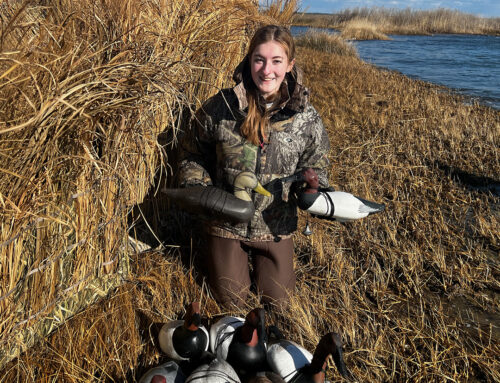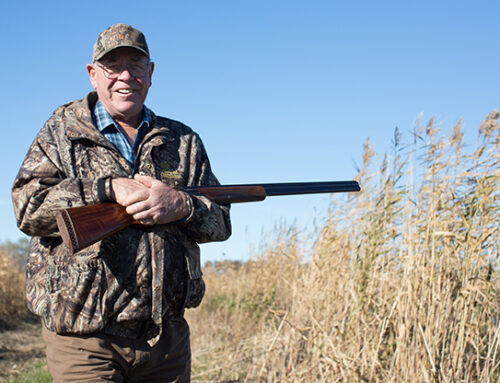Flight of the Electrified Pterodactyls

By Bill Miller
A couple weeks into each North Dakota waterfowl season, Ken “The Crane Man” Toop and his gang of ne’er-do-wells invaded the tiny town of Robinson, North Dakota. The crew always headquartered at the historic bank building on Main Street. It was, long ago, converted to a boarding house mostly to meet the needs of the duck and goose hunters who use the town as base camp from opening day to freeze up. Next door is the Kountry Korner Café that extended its hours during the waterfowl season to become the only place for 30 miles around to find a meal on hunters’ hours.
When the hunter invasion hits Robinson, it can look like a gypsy caravan. Clotheslines are strung between vehicles to dry clothing and equipment. Dogs are everywhere. Camp chairs and sacks of decoys and drying layout blinds turn a block or two of sidewalk into an obstacle course.
 Through a friend of a friend of a friend, I’d finagled an invitation to join The Crane Man to experience hunting birds I’d heard called, “ribeye of the sky.” As a guest of honor, my bedroom was the old vault in the basement of the bank, complete with the original 8-inch thick steel door. (For the sake of guests with claustrophobia, the locking mechanism is thankfully dismantled.) To this day, I honestly don’t know if they were being kind by shielding me from their snoring or selfish in protecting themselves from mine!
Through a friend of a friend of a friend, I’d finagled an invitation to join The Crane Man to experience hunting birds I’d heard called, “ribeye of the sky.” As a guest of honor, my bedroom was the old vault in the basement of the bank, complete with the original 8-inch thick steel door. (For the sake of guests with claustrophobia, the locking mechanism is thankfully dismantled.) To this day, I honestly don’t know if they were being kind by shielding me from their snoring or selfish in protecting themselves from mine!
The Crane Man’s moniker was well-earned. Toop’s passion was hunting sandhill cranes. He specially built his own decoy spreads from a combination of hand-painted, full-body decoys and tall sticks with tan plastic rags tied in a particular way.
Toop pioneered his own crane calls, too, and he built upright blinds into which he carefully wove whatever harvest leavings could be gathered in the field selected for a given morning’s hunt. The blinds had tiny peepholes through which to spy incoming birds, but those walls might have just as well been solid. In the blind, the mild-mannered crop insurance agent became super-villain tyrannical about sitting still and not looking at the birds. Toop watched the birds. Toop called the shots. After all, he was The Crane Man.
It was the final day of this particular trip. As hunters began to stir in the bank — making coffee, heating cinnamon rolls and such — I got up and went outside to let the dogs out of the truck. It was warm for October. The wind blew. Constant lightning flashed in the southwest. Feeling the first raindrops on my neck, I hurried Sadie and Belle through their morning routines.
After delivering the weather report, I joined the debate over plans for the morning hunt. The field scouted the night before was about 30 miles away – it might be completely out of the storm’s path. On the other hand, we had already enjoyed several days of incredible hunting. Maybe the storm was a sign we should sleep in, pack up, head home.
Of course, as minions of The Crane Man, we had no choice. We went hunting, but because of the conversation, arrived at the field late. The storm was not far behind.
Though we routinely hunted as a group, this morning’s plan was to split up. The series of winding sloughs interspersed with harvested fields, and my decision to leave earlier than the rest for my long drive home, dictated this strategy.
Hurrying to be in position by legal shooting time and to find some kind of cover in advance of the storm, I cut too close to the edge of one shallow slough. The roosting cranes noticed. They took flight with a roar mightier than the thunder.
I said a quick prayer I wouldn’t incur the wrath of The Crane Man for busting the roost, then hurried on to a small rise in the grain field above the slough and found a rock pile. Belle and I tucked in tightly against the rocks seeking some sort of break from the windblown rain.
Though it was now several minutes into legal shooting, the heavy clouds kept it nearly as black as midnight. Lightning flashed all around. Belle and I lay flat in the weeds hoping it wouldn’t get any closer.
The cranes didn’t like the lightning either. Each time the flocks would line out in one direction, the electricity wove a net of lightning among the low, leaden clouds to turn them back.
For an hour, the surreal show continued. Swarms of huge, prehistoric-looking birds crisscrossed the sky. They were from gun barrel high to 300 feet up. Their trilling was deafening. The juvenile birds sounded like a thousand traffic cops randomly blowing their whistles. The calling was so close it reverberated in the raindrops. With thousands of the long-billed, gangly-legged birds silhouetted against the lightning and growing daylight, the scene seemed the stuff of computer-generated special effects in a Hollywood horror movie.
When the storm finally blew past and the birds moved on, I realized I’d never loaded my shotgun. So I did.
Then Belle and I stood up, walked down to the edge of the slough, and I shot a limit of six ducks of six different species.
We hiked to where Toop and the rest were already picking up their decoy spread because they had limited on cranes in the first flurry. Several birds fell in small potholes, so Belle made her first crane retrieves that morning, too.
Retrieving cranes can be dicey business, especially for a diminutive dog like Belle, so I made certain there was no life left in any of them before sending her into the pond. As she brought each bird ashore, and dragged it through the stubble to deliver, it struck me again what an odd scene this was, as though I was watching it as both a spectator and a participant. She brought each bird to my hand, shook off the slough water, and spun around eager to get the next.
Ten hours later, when I pulled into my driveway at home, I was still in a mild state of euphoric shock. After all, when might I again have the chance to sleep in a bank vault, hunt with a super-villain, see my dog retrieve pre-historic remnants, and play a starring role in the next waterfowl hunters’ box office thriller, “Flight of the Electrified Pterodactyls?”
That just doesn’t happen to a guy everyday, now, don’t you know?






That is a fine story, well worth reading. An experience inaccessible to the sleepers-in. As is so often the case, difficult to do justice to with words, so perhaps it should be chalked up to a question a very fine acquaintance of mine used to ask on such occasions. “I wonder what the poor people in the world are doing?”